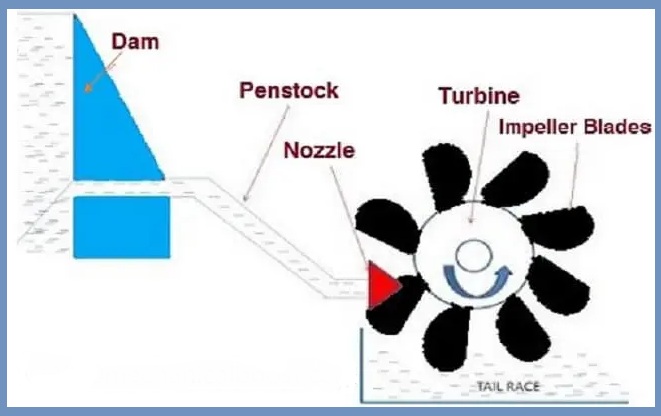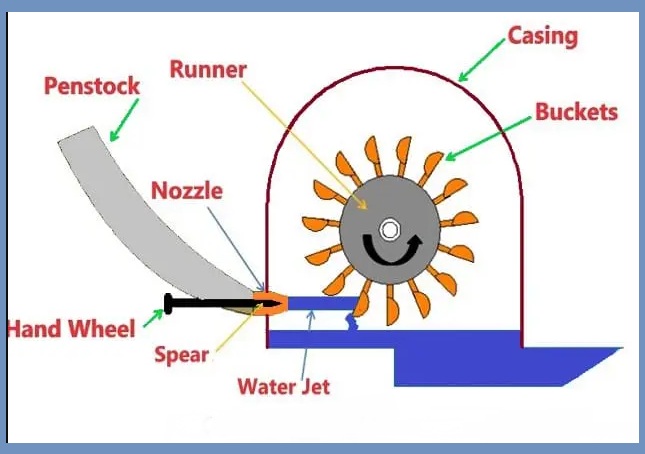An impulse turbine is a type of turbine in which a stream of water collides with turbine blades at high speed to rotate the turbine and generate electricity. Impulse turbines operate on the principle of Newton’s second law. French Real and Pichon invented the combined impulse turbine in 1827.
Impulse turbines are the most accessible type of turbine. Includes a set of blades and a set of nozzles. Nozzles and blades are the main components of impulse turbines.
The Impulse Turbine has multiple static nozzles that convert the pressure of a water jet into kinetic energy. After passing through the nozzle, the water hits the blade of the impeller. Turbine runner blades absorb almost all of the kinetic energy of a water jet and convert it to water speed. These turbines are used for low water flow rates and high heads.

The main difference between a reaction turbine and an impulse turbine is that in an impulse turbine, all the hydraulic energy of the water is emitted from the K.E. nozzle. Is converted and no pressure change occurs during the process. In contrast, reaction turbines convert only certain parts of the available energy into kinetic energy.
Table of Contents
How Does Impulse Turbine Work?
The impulse turbine running precept is consistent with the primary impulse precept. Newton`s 2d regulation of movement explains the impulse turbine running precept. For impulse turbines, the water is saved in excessive locations and flows thru the turbine nozzles.
Impulse turbines work as follows:
Water moves from the reservoir or dam to the fixed nozzle of the turbine. When water enters the nozzle, the nozzle converts the potential energy of the water into kinetic energy, increasing the speed of the water. After exiting the nozzle, this high-speed water jet hits the impeller blade and rotates the impeller on its own axis. The turbine shaft is connected to the rotor. As the rotor rotates, its movement is transmitted to the shaft. The turbine shaft is also connected to the generator coil. The shaft transmits its rotational motion to the generator coil, which rotates the coil. When the generator coil rotates, it converts the received mechanical power (that is, rotational motion) into electric power. This generated electricity will be supplied to various industries and homes.

Various Parts of Impulse Turbine
Here are the important parts of the impulse turbine.
- Buckets
- Runner
- Casing
- Nozzle
- Spear
- Penstock

Types of Impulse Turbine
- Pelton Wheel Turbine
- Turgo Turbine
- Cross-flow Turbine
How to Increase the Impulse Turbine Output?
Depending on the load on the turbine, a spear moves in and out of the nozzle to control the flow of water. For best yields from the
turbine, the speed of the waterjet hitting the runner blades should be twice the speed of the moving blades. The water injection rate must match the turbine speed and load in order to keep the turbine running in the most efficient range.
It is recommended to use 3-4 nozzles instead of one. In this way, the power of the turbine is increased and can withstand heavy loads. When the turbine is under load, turn off some jets to adjust performance. If the turbine load drops sharply and the spear cannot quickly adjust the flow of the water jet, the turbine speed will continue to increase and the turbine may be damaged. To avoid this, a deflector should be used to keep the water flow away from the turbine blades. Keep the turbine in a safe place.
Advantages
- Easy to maintain.
- Its structure is very simple.
- The efficiency of the impulse turbine is high.
- Assembling these turbines is easy.
- It operates at atmospheric pressure. It’s fast.
Drawbacks
- Its size is large compared to other turbines.
- You need a tall head that is awkward.
- Efficiency decreases over time.
- High installation cost.
- Not the best turbine for high flow rates.
- Ideal for low discharge only.
Application/Uses
- Used in drinking water supply systems.
- Impulse turbines are most commonly used in hydroelectric power plants.
